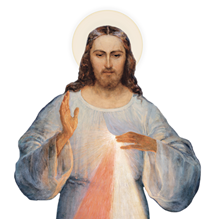
The following the 18th and final part of a special series on the role Mary plays in the life of the Church.
Consider old Simeon's prediction about the "sword" of sorrow that would one day pierce Mary's heart (Lk 2:35). There can be little doubt that this prophecy was fulfilled most of all on Calvary.
At the foot of the Cross, Mary bore the greatest sorrow that a mother's heart could ever endure: She witnessed the public execution by torture of an innocent man, her own son, the Son of God. For this reason, in Catholic Tradition, Mary is rightly called "Queen of Martyrs," as Blessed John Henry Newman explained:
Why is she so called? - she who never had any blow, or wound, or other injury to her consecrated person. How can she be exalted over those whose bodies suffered the most ruthless violence and the keenest torments for our Lord's sake? ...
To answer this question, it must be recollected that the pains of soul may be as fierce as those of the body. ... What an overwhelming horror it must have been for Blessed Mary to witness the Passion and Crucifixion of her Son! Her anguish was, as holy Simeon had announced to her at the time of her Son's presentation in the Temple, a sword piercing her soul.
Saint Alphonsus passes down this same Catholic Tradition when he writes in The Glories of Mary:
To show the sufferings endorsed by other martyrs, they are represented with the instruments of their torture; St. Andrew with a cross, St. Paul with a sword, St. Laurence with a gridiron; Mary is represented with her dead Son in her arms; for he alone was the instrument of her martyrdom, and compassion for him made her the Queen of Martyrs. ...
Arnold of Chartres writes that "whoever had been on Mount Calvary, to witness the great sacrifice of the Immaculate Lamb, would there have beheld two great altars, the one in the body of Jesus, the other in the heart of Mary; for on that Mount, when the Son sacrificed his body by death, Mary sacrificed her soul by compassion."
By sharing in this profound way in the sufferings of Christ, Mary shows us how we, too, can share in the redemptive work of her son. Whenever we take our own pains or sorrows and offer them up to the Father, in union with Christ's Passion, then our sufferings can obtain for others (whether they are on earth or in Purgatory) a share in all the graces that our Savior merited for us on the Cross.
As St. Paul wrote in Colossians 1:24: "I rejoice in my sufferings, for I make up in my own body what is lacking in the sufferings of Christ for the sake of His body, which is the Church." In this way, life's unavoidable sufferings and sorrows can find meaning and purpose, and can even be put to good use. For, as Catholics, we are not only to do good to the suffering by bringing them relief and comfort; we are also to do good with our suffering, offering it up in love for the salvation of souls. This is the Catholic doctrine known as "redemptive (or co-redemptive) suffering," a mystery of the Catholic faith spelled out clearly in St. John Paul II's 1984 Apostolic Letter Salvifici Dolores (On the Christian Meaning of Human Suffering) (1984).
It is important to remember, however, that Mary's sharing in the sufferings and sorrows of Christ, and her cooperation in His redeeming work, was in certain respects unique and unrepeatable. That is why St. John Paul II taught that, applied to Mary, the term "co-operator" in Christ's saving work acquires a special meaning:
The collaboration of Christians in salvation takes place after the Calvary event, whose fruits they endeavour to spread by prayer and sacrifice. Mary, instead, cooperated during the event itself and in the role of mother; thus, her cooperation embraces the whole of Christ's saving work. She alone was associated in this way with the redemptive sacrifice that merited the salvation of all mankind. In union with Christ and in submission to him, she collaborated in obtaining the grace of salvation for all humanity. (General Audience of April 9, 1997)
The last of the sufferings and sorrows of Mary in the Gospel story occurred when she received His lifeless body as He was taken down from the Cross, and assisted in laying Him in the tomb.
Saint Alphonsus writes:
When a mother is by the side of her suffering and dying child, she undoubtedly feels and suffers all his pains; but after he is actually dead, when, before the body is carried to the grave, the afflicted mother must bid her child a last farewell, then, indeed, the thought that she is to see him no more is a grief that exceeds all other griefs. Behold the last sword of Mary's sorrow, which we have to consider; for after witnessing the death of her son on the cross, and embracing for a last time his lifeless body, this blessed Mother had to leave him in the sepulchre.
Here, the Blessed Virgin shares in that most poignant human sorrow of all: the sorrow of bereavement. But, again, there is something unique about the grief in the heart of Mary that goes beyond the bereavement experienced by any other creature. Archbishop Sheen explains:
All the fatherless, sonless, husbandless, and wifeless griefs that ever tore at the heart of human beings were now bearing down on the soul of Mary. The most any human being ever lost in bereavement was a creature, but Mary was burying the Son of God. It is hard to lose a son or a daughter, but it is harder to bury Christ.
By experiencing in so many ways the deepest wounds and sorrows that a created human heart could possibly experience, Our Lady, full of grace, became the most compassionate of all creatures. It is this virtue that makes her so accessible to us today as our spiritual Mother in Heaven, for her sorrows were transformed by divine grace, through the gifts she received of faith and love, into the virtue of compassionate love for us all, "the rest of her offspring" (Rev 12:17). Thus, the final chapters of The Imitation of Mary invite us to consider that the Blessed Virgin is always our Mother of merciful love and tender compassion:
In creating you, Mary, God intended you to be our advocate, our refuge, our consolation, our mother. Therefore He made you a woman of immense compassion and mercy. ...
We do not think of you, even though the Church has taught us from our childhood to address you as "Consoler of the afflicted, and Help of Christians." That is indeed what you are. Can anyone claim to have invoked you and not been heard? ...
If your intercession does not always obtain for us from God all the graces we want, that is for reasons into which we should not inquire. But your intercession always wins for us at least the grace of patience, submission, and resignation to God's will. ...
Whatever be the sad circumstances in which we find ourselves, you cannot refuse us your help, for your kindness is unlimited.
Prayer
Recite the Chaplet of the 10 Evangelical Virtues of the Blessed Virgin Mary and prayerfully reflect on Mary's virtue of sorrow.
Questions for Discussion for Parts 17 and 18
1. In the last two articles in this series, we meditated on the sorrows of Mary during the sojourn of the Son of God upon earth. Is there any particular sorrow that Mary experienced that is in some way similar to a sorrow that you have experienced in your own life?
2. What does it mean to "offer up" one's sufferings and sorrows, in union with the Passion of Jesus Christ on the Cross? What good can that possibly do for others?
3. Why do you think that God permitted Mary to suffer so many hardships and sorrows along her life journey?
Access the entire series.
Robert Stackpole, STD, is director of the John Paul II Institute of Divine Mercy. His latest book is Mary - Who She Is and Why She Matters (Marian Press).

















